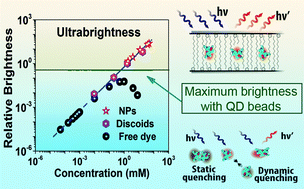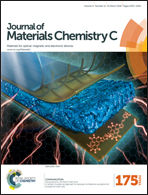The nature of ultrabrightness of nanoporous fluorescent particles with physically encapsulated fluorescent dyes†
Abstract
Here we investigate the phenomenon of ultrabrightness of rhodamine 6G dye physically encapsulated in nanopore of silica particles, both of nano- and micro-size. We demonstrate that the dye can be packed inside nanoporous silica up to rather high concentrations (∼50 mM) without noticeable dimerization, which is several orders of magnitude higher than for free dye in water. Fluorescence and absorbance spectra of the dye, its fluorescence lifetime, quantum yield, brightness, and anisotropy before and after encapsulation are studied for different dye concentrations. The temperature dependence of fluorescence reveals the mechanism of dye homo-quenching. Interestingly, the mechanisms of self-quenching of the dye inside discoids and nanoparticles turned out to be different for large concentrations. The mechanism is defined mostly by the dynamic quenching inside the nanoparticles up to the maximum concentration observed of 50 mM, whereas the quenching of the dye inside the discoids is driven by the static quenching above several mM. Both types of particles demonstrate collisional quenching for small concentrations of encapsulated dyes. All measurements are consistent with low dimerization of the encapsulated dye, and the consequent high fluorescence brightness. Physical reasons of such behavior are discussed.


 Please wait while we load your content...
Please wait while we load your content...